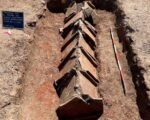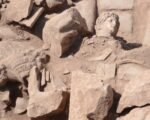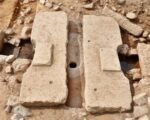The Discovery of Abarkuh’s Underground City
The underground city was discovered beneath five houses in the historic town of Abarkuh, located in central Iran, within the “golden triangle” of Shiraz, Yazd, and Isfahan. The discovery began when archaeologists detected stone chambers beneath gardens in the town. These stone beds, initially believed to be simple foundations, turned out to conceal pathways leading to an extensive network of subterranean tunnels.
Hossein Hatami, the governor of Abarkuh, explained that the spaces between these stone chambers had been transformed into gardens by the ancient inhabitants. “They had foreseen paths under these stone sections for ease of access, security, water transportation, and their lives,” Hatami said. The tunnels beneath the stone beds indicate that these chambers had a specific and vital function in the past, likely linked to both water management and protection during times of conflict.

A Vast, Expanding Network
The underground city is estimated to cover 650,000 square feet, but experts believe it may stretch even further across Abarkuh. Hatami suggested that the subterranean complex could extend beneath other neighborhoods in the city, possibly encompassing the entire historic area. Archaeological research is ongoing, as the full extent of this underground network remains to be uncovered.
The tunnels are believed to have been built during the era of the Qajar dynasty, a period spanning from the 18th to the early 20th century. The stones used in constructing the underground system match those found in other Qajar buildings in the region, suggesting that the Qajars were likely responsible for their creation.
Functionality of Abarkuh’s Underground Tunnels
The primary purpose of these tunnels appears to have been water management. Abarkuh, located in the arid desert of Iran, was heavily dependent on an advanced irrigation system. According to Irina Tsukerman, a geopolitical analyst, the tunnels were designed as part of the qanat system—a series of underground canals used to transport water from aquifers to the surface for irrigation, drinking, and other daily needs.
“The qanat tunnels were crucial for ensuring a steady and reliable water supply to the city,” Tsukerman explained. “They allowed for water to flow from distant sources to Abarkuh, reducing evaporation and maintaining a consistent supply in the region’s hot and dry climate.” The qanats were designed to be deep and well-ventilated, allowing the water to remain cool as it traveled through the underground channels.
Beyond their role in water transportation, the underground tunnels also served as a cooling system. During the hot summer months, the cool and dark nature of the tunnels provided a welcome escape from the scorching desert heat. These underground spaces likely offered protection and respite for the people of Abarkuh during times of extreme temperatures or even during times of war and invasion.
A Window into Ancient Engineering
The discovery of this subterranean settlement highlights the advanced engineering techniques of the past inhabitants of Abarkuh. Not only did they develop an efficient system for managing water in a desert environment, but they also designed a network that served multiple functions, including cooling, security, and agricultural support.
As archaeological research continues, experts hope to learn even more about the history of this underground city and how it fits into the broader context of Abarkuh’s past. This discovery adds a new layer to the understanding of the region’s rich history and the ingenuity of those who lived there centuries ago.













